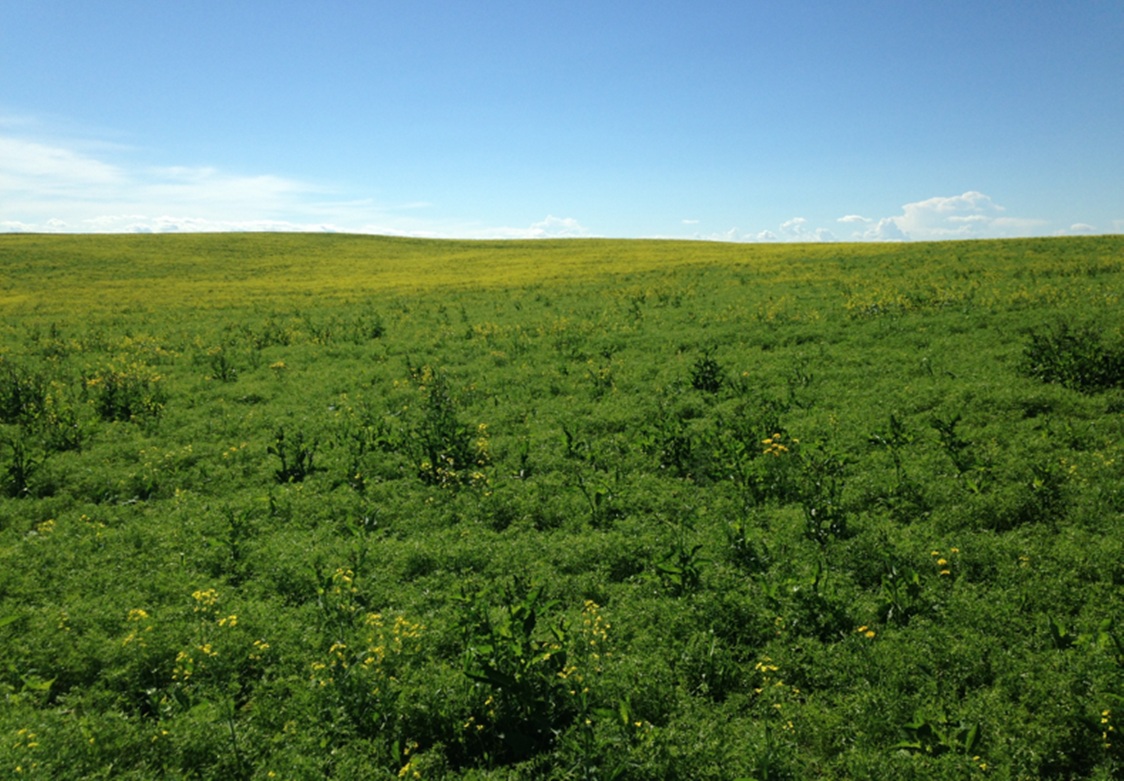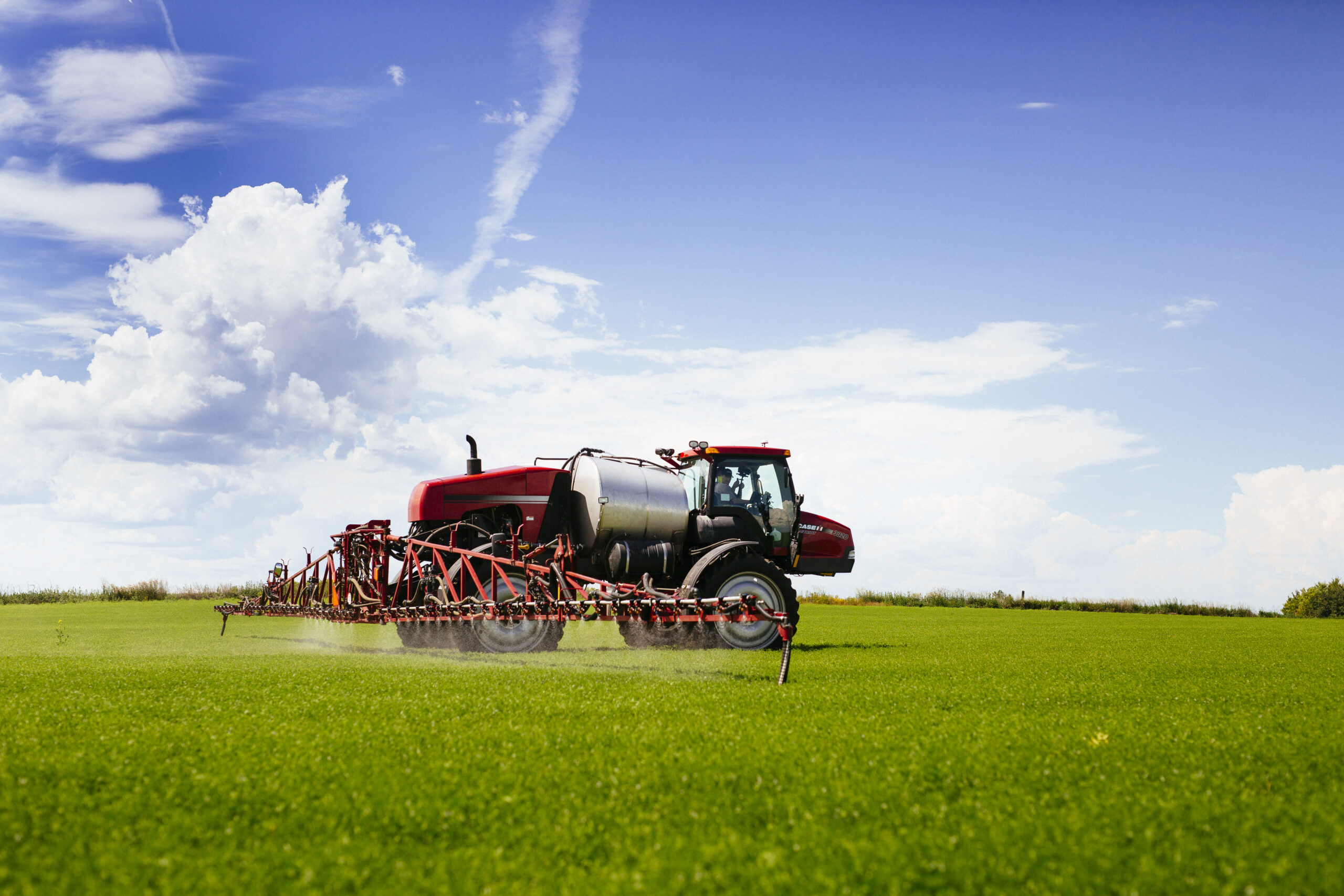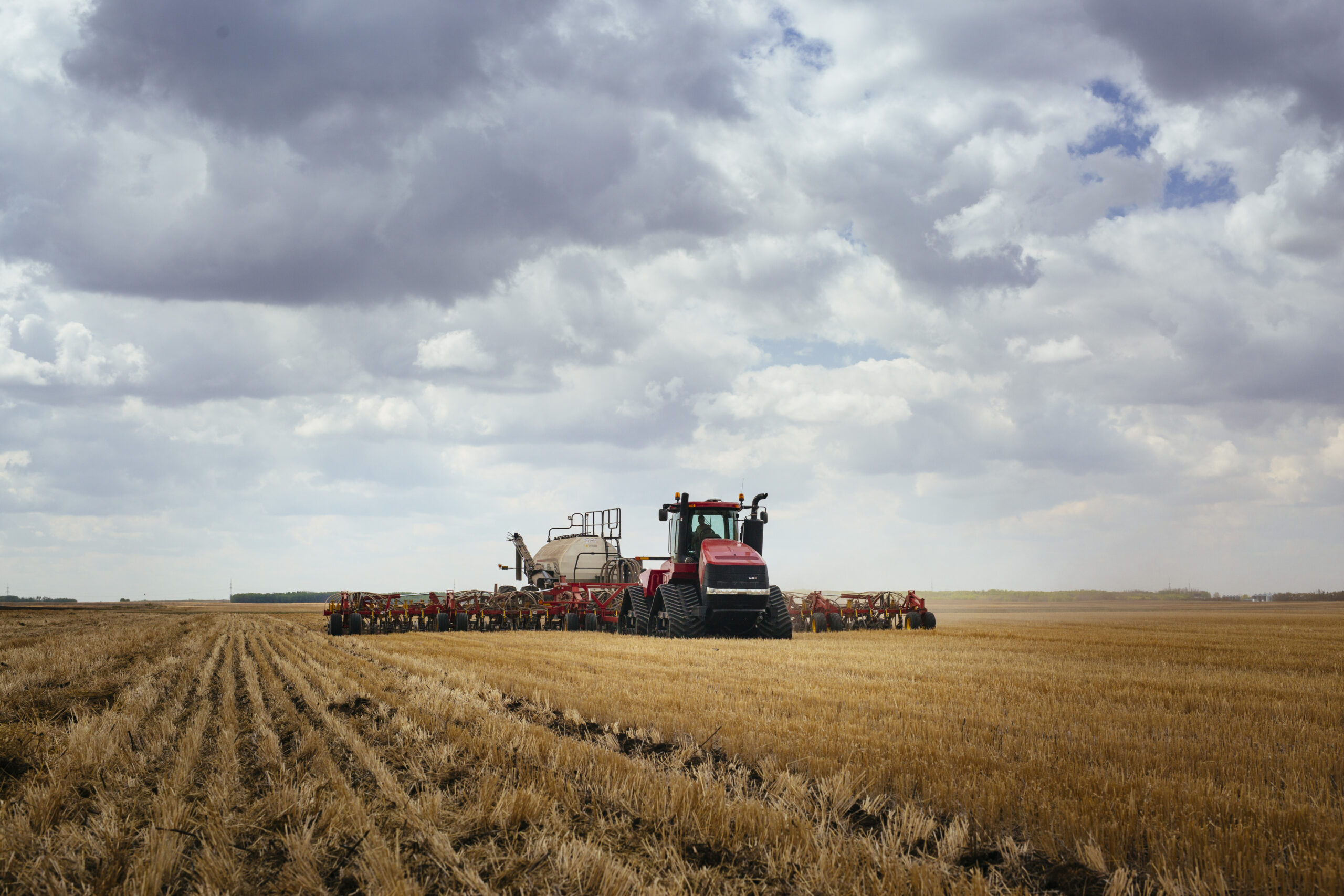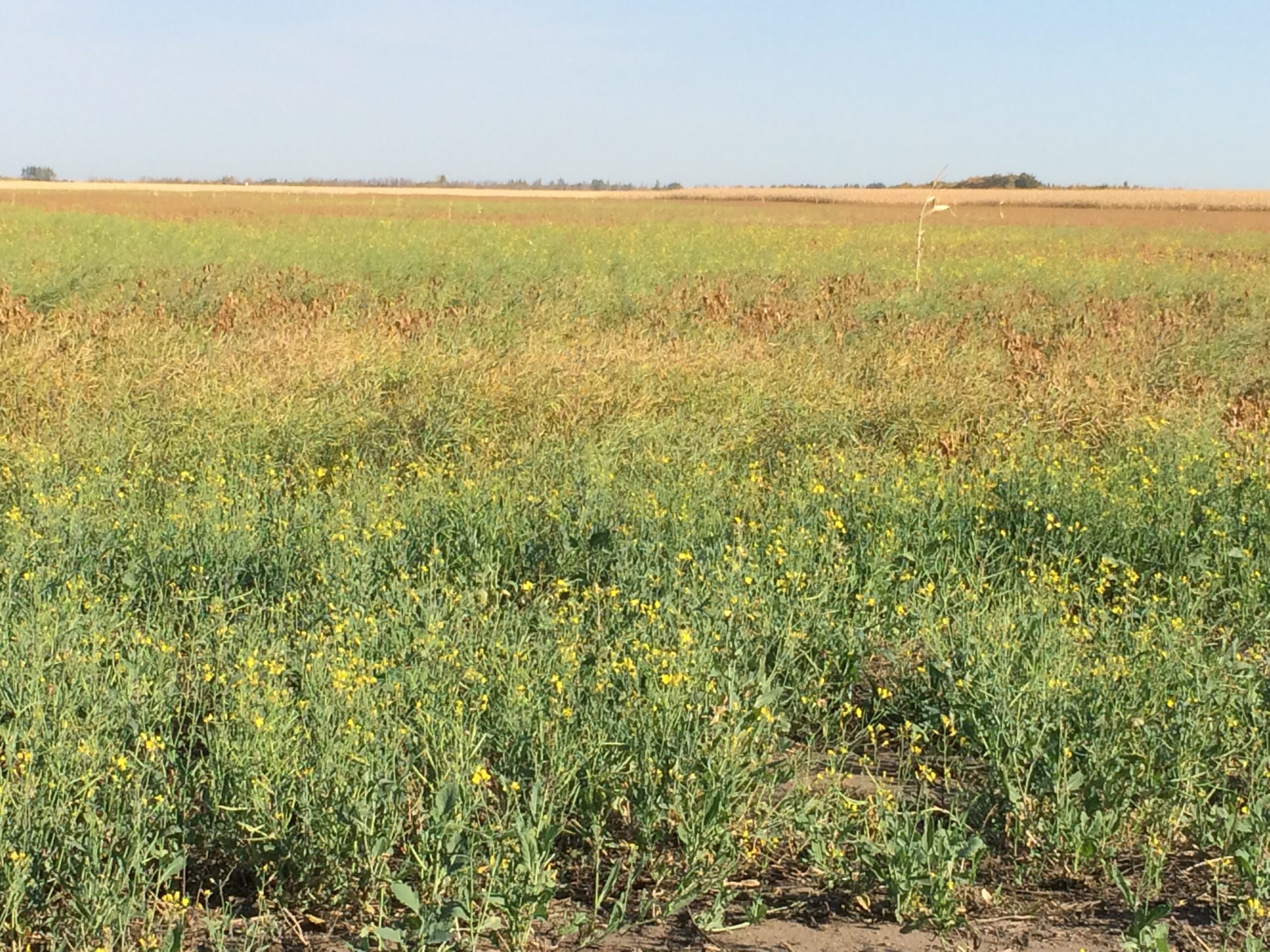Jennifer Bogdan, P.Ag., CCA
Wild mustard is a problematic weed for Saskatchewan pulse growers and has a number of herbicide resistant populations confirmed within the province. In particular, Group 2 resistant wild mustard is very difficult to control in Clearfield® lentils due to the lack of effective herbicide options. Wild mustard has competitive early season growth, high seed production, and long seedbank dormancy that creates an extended management challenge for years to come.
History, Distribution, and Adaptation
Wild mustard is indigenous to Europe, Western Asia, and the Middle East, and can now be found in the majority of temperate regions worldwide. Its occurrence has been documented in all Canadian provinces and territories. It was originally thought that wild mustard and similar brassicas were brought to North America by Europeans however, seeds of wild mustard dating from over 8,000 years ago found in northeastern United States suggest this plant has been present significantly longer on the continent. The first official record of wild mustard in Canada was in 1829 in Nova Scotia, and in Western Canada, was in 1860 in Fort Garry, Manitoba.
Surveys in Manitoba from 1956-1958 found wild mustard to be the most common weed in grain fields. In the late 1970s, provincial surveys showed wild mustard was present in over 22% of fields in Saskatchewan (Figure 1).

Field Density (occurrence fields): A measure of the number of wild mustard plants counted in a square metre. The density values in a single field are averaged over only the fields in which wild mustard occurred in groups such as crops or ecoregions, and in the province.
Source: Leeson, J.Y. 2016. Saskatchewan weed survey cereal, oilseed and pulse crops in 2014/15. Weed Survey Series Publication 16-1. Agriculture and Agri-Food Canada, Saskatoon Research Centre
With the introduction of Group 2 (ALS inhibitor) herbicides in the late 1980s and early 1990s, which allowed growers to control wild mustard in canola, the frequency of wild mustard decreased. In 1996, Roundup Ready® canola was introduced in Canada, which further increased the control of wild mustard in canola crops, and wild mustard populations reached an all-time low in 2003. However, with the extended overuse of Group 2 herbicides in multiple crops (cereals, canola, pulses), wild mustard populations began to develop resistance to these herbicides. In the 2014/15 Saskatchewan weed survey, wild mustard was ranked the 21st most abundant weed in all crops, but was ranked ninth abundant in pea fields and 10th in lentil fields. While Group 2 resistant populations are more difficult to detect using the frequency number alone, the high uniformity and density of wild mustard in fields where the weed was present may be indicative of fields with uncontrolled resistant populations. The next weed survey for Saskatchewan is scheduled for 2019.
Wild mustard is well adapted to various habitats, including fields, gardens, roadsides, railways, disturbed sites, river banks, and shores. It favours cultivated fields and is a primary colonizer on disturbed soils, due to the germination of dormant seeds in the seedbank.
On the Prairies, wild mustard is most common in the Dark Brown soil zone, and is particularly competitive on heavy clay soils within this region. Wild mustard can also serve as a host plant for the pathogen causing clubroot in canola. Wild mustard has been reported to decrease pea yield by 2-35% and navy bean yield by 52% (from in-row competition) at a density of 20 plants per square metre (m2). It is very competitive in its early stages of growth, partially due to a substantially higher density of stomata on its leaves compared to a number of other broadleaf weed species, cereal crops, and wild oats (ex. 31,800 stomata per square centimetre (cm2) in wild mustard versus 4,700 stomata per cm2 in wheat). One role of the stomata is to regulate gas exchange during photosynthesis by allowing carbon dioxide to enter the plant and oxygen to exit. A higher density of stomata means a higher rate of photosynthesis, allowing for faster plant growth. Wild mustard produces leaf area quickly, making it a strong competitor for both light and soil moisture, and will even outcompete canola in this manner.
Biology
Sinapis arvensis L. [synonym Brassica kaber (DC.) Wheeler], also known as charlock or field mustard, is an annual plant in the Brassicaceae (formerly Cruciferae) or mustard family. Cotyledons are kidney-shaped with a deep, wide notch at the end. True leaves are alternate and moderately hairy, especially along the veins on the underside, and can be purplish close to the stem (Figures 3 and 4).

Source: Nutrien Ag Solutions

lobed leaves and a deep notch in the cotyledons.
Source: Jennifer Bogdan

Source: Jennifer Bogdan
Lower leaves have stalks while the upper leaves are stalkless. Stems are hairy and are often purple where the branches attach to the main stem. Plants can grow from 30 to 100 cm tall. Flowers are bright yellow and approximately 1.5 cm in diametre (Figure 5). Pods are typically hairless, 3-5 cm long, and end in a flattened beak. Seeds are 1-2 mm long and are usually black, but can also be reddish-brown.
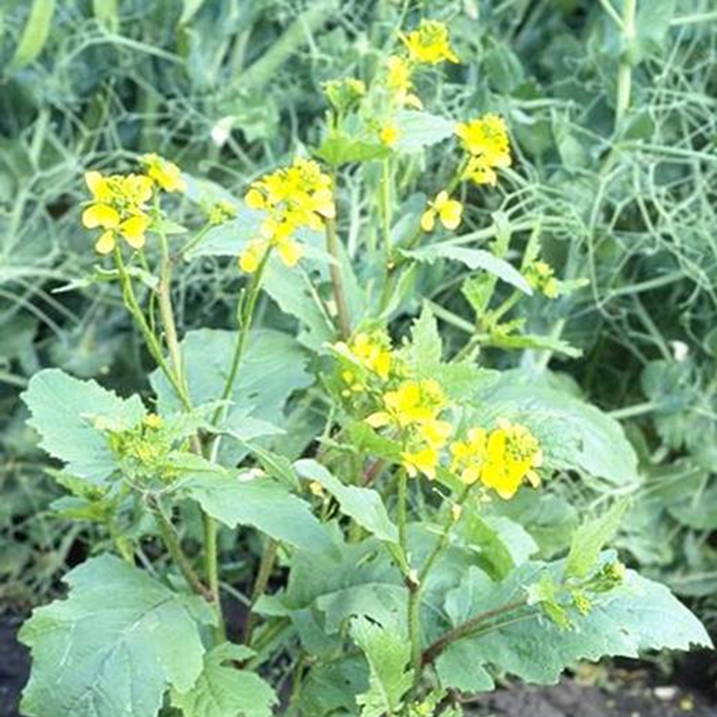
Source: Nutrien Ag Solutions
Wild mustard produces a taproot in combination with an extensive fibrous root system. Compared to eight other weed species (wild oats, stinkweed, lamb’s-quarters, cow cockle, hare’s-ear mustard, redroot pigweed, Russian pigweed, and tumbling mustard) and four kinds of cereal crops (wheat, barley, oats, and spring rye), wild mustard had the largest root system 21 days after emergence.
Wild mustard can appear similar to many other brassicas, such as Brassica napus (Argentine canola), Brassica rapa (Polish canola), Brassica juncea (Oriental or Indian mustard), or Sinapis alba (white mustard), but compared to all of these species, only wild mustard contains one or two seeds in the beak of the pod (Figure 6). At the vegetative stage, wild mustard can be distinguished from Argentine canola by its hairy stems and green leaves versus the hairless stems and hairless, bluish-green leaves of canola.
In the spring, wild mustard germinates early at temperatures around 4°C. In a 1934 Saskatchewan study, only about 20% of newly produced seeds germinated after four to 20 days, regardless if soil moisture was abundant or scarce. Wild mustard seed can experience long periods of dormancy and can remain viable in the soil for well over 60 years. In a 110-year old mixed seed sample (the Vienna Sample of 1877) stored in ultra-dry conditions, wild mustard seeds achieved 32% germination. Burial of wild mustard seeds at depths of 15-20 cm favours seed survival compared to shallow (2 cm) burial, possibly due to lower oxygen levels at deeper depths. Wild mustard germination is favoured by a combination of triggers – some exposure to light, some soil aeration, and the presence of nitrate (NO3-) and ammonium (NH4+). Since all of these requirements are met during typical field operations, wild mustard is well-adapted to agricultural systems on the Prairies.

Source: John M. Randall, The Nature Conservancy, Bugwood.org
Wild mustard is an outcrossing species that relies on insects for pollination. Wild mustard produces protogynous flowers in which the female flower parts (stigmas) emerge before pollen from the male flower parts (anthers). During this time, the stigma receives pollen from outside sources and then deteriorates before pollen is released from that flower’s own anthers, thus preventing self-pollination of individual flowers. Wild mustard is cross-pollinated by the numerous native insects attracted to their bright yellow and odoriferous flowers. Pod formation and seed production continue until a killing frost due to the indeterminate growth habit of wild mustard. Upon maturity, pods remain largely intact so natural seed shatter is low, approximately 10%. Pods are easily split open during crop harvest operations and some seeds are either collected with the crop or drop to ground near the parent plant, but most are likely spread with the chaff onto the rest of the field. Field-grown wild mustard plants in Western Canada can produce 10-18 seeds per pod and 2,000-3,500 seeds per plant.
Herbicide Resistance
Herbicide Resistance Timeline

Source: Jennifer Bogdan
In Western Canada, wild mustard has been found to be resistant to Group 2, 4, and 5 herbicides. However, Group 2 resistance is by far the most common that has developed, and to date, is the only resistance found in Saskatchewan and Alberta wild mustard populations (Figure 7).
The first herbicide resistant wild mustard population in Western Canada was found in wheat and barley fields in Manitoba in 1990, and was resistant to Group 4 (Synthetic Auxins) herbicides, including 2,4-D, MCPA, dicamba, mecoprop, and dichlorprop (Table 1). Over the next few years, Group 2 (ALS inhibitor) resistance was found in both Manitoba and Alberta. In 1994, wild mustard resistant to metribuzin (Sencor®), a Group 5 (Photosystem II) herbicide, was found in lentil and wheat fields in Manitoba. Saskatchewan had its first case of Group 2 resistant wild mustard in 2002, where it was found in canola and cereal fields that had seven years of Group 2 herbicides applied. In the most recent herbicide-resistant weed survey conducted in Saskatchewan in 2014/2015, Group 2 wild mustard was detected in 25% of fields surveyed (six out of 24 fields). This finding was the same as in 2009 (also 25%, two out of eight fields), but a notable increase from the 2003 survey where no resistant wild mustard was found, although Group 2 resistant biotypes had been identified in the province by that time. Globally, the majority of resistant wild mustard populations are resistant to Group 2 herbicides, and only one case of multiple-resistance has been documented – a Group 2 + Group 4 biotype in wheat in Turkey, found in 2008.
Table 1. Timeline of Confirmed Herbicide-Resistant Wild Mustard Populations in Western Canada
| 1990 | Group 4 resistance confirmed in Manitoba |
| 1992 | Group 2 resistance confirmed in Manitoba, due to a target site mutation |
| 1993 | Group 2 resistance confirmed in Alberta, due to enhanced metabolism |
| 1994 | Group 5 resistance confirmed in Manitoba |
| 2002 | Group 2 resistance confirmed in Saskatchewan, due to a target site mutation different than the Manitoba biotype |
| 2009, 2014/15 | Saskatchewan survey found Group 2 resistant wild mustard in 25% of fields |
Mechanisms of Resistance
Most Group 2 resistance is conferred by a mutation at the target site, the ALS enzyme, where the resistant plant substitutes one amino acid for a different one, and the herbicide can no longer bind to the enzyme. Different amino acid substitutions will result in different degrees of resistance to the chemical families within the Group 2 herbicide class. For example, the 1992 Group 2 resistant biotype in Manitoba is due to an amino acid substitution that allows the wild mustard to be resistant to sulfonylurea (SU) herbicides, but remain susceptible to imidazolinone (IMI) herbicides. In contrast, the 2002 Group 2 resistant wild mustard in Saskatchewan has a different amino acid substitution that makes the plant resistant to both SU and IMI herbicides. To a lesser extent, Group 2 resistance in wild mustard can also be the result of enhanced metabolism of the herbicide in the plant, as is the case for the 1993 Group 2 resistant biotype found in Alberta. In this biotype, the ALS target site was not altered, but the herbicide (ethametsulfuron-methyl, or Muster®) was metabolized and broken down more quickly by the resistant plants compared to susceptible plants, in the same way conventional canola and brown mustard are able to break down ethametsulfuron-methyl to avoid injury. Although this wild mustard biotype was resistant to the SU family, it was still susceptible to the IMI family.
Though not as well-studied as Group 2 resistance, Group 4 resistance in wild mustard is believed to be due to an altered target site and cross-resistance to all Group 4 herbicide families is observed. The mechanism for Group 5 (metribuzin) resistant wild mustard has not been studied but is also thought to be the result of target site mutation.
In all of the above documented cases, resistance developed due to applications of herbicides within the same group over multiple, consecutive years. Single, dominant to semi-dominant resistance genes are passed on in both the pollen and the seed. Since wild mustard is a highly outcrossed species, resistant genes are easily spread by insects to susceptible wild mustard plants which then produce seed that will be resistant. Due to the extended longevity of wild mustard seed, once a resistance population develops on a field, it likely will never go away.
Resistance Testing
If wild mustard resistance is suspected, seed samples should be tested to identify issues early so growers can start managing herbicide resistant populations before they become a much bigger problem. Testing services are available at the Government of Saskatchewan Crop Protection Lab in Regina or at Ag-Quest in Minto, Manitoba. Since resistance across the Group 2 herbicide families can differ depending on the specific type of mutation in the wild mustard population, it may be advisable to test for resistance to families other than the one suspected. For example, if IMI resistance is suspected in a pulse crop, consider testing for SU resistance at the same time, as this information will help with crop and herbicide planning in non- pulse years as well.
Agriculture and Agri-Food Canada in Lethbridge is currently testing for herbicide-resistant weed biotypes that have not been previously found in each of the Prairie provinces. Their work is focused on confirming new types of resistance, so they are looking for more unique cases of herbicide resistance. Specifically, in Saskatchewan and Alberta, suspected cases of Group 4 or 5 resistant wild mustard will be accepted, and in Manitoba, only suspected cases of wild mustard with multiple resistance to Groups 2, 4, or 5 will be accepted. Contact Dr. Charles Geddes for a sample submission form and more information.
Wild Mustard Management in Pulses
Herbicides are an important tool for wild mustard management but their longevity will only be maintained if they are used as part of an integrated weed management plan that also includes cultural, mechanical, and biological control. The main features of wild mustard that make it a successful weed are its competitive early season growth, high seed production, and long seed dormancy that contributes to a lasting problem. The key strategies for managing wild mustard are to eliminate early growing plants that have emerged before the crop, promote a competitive crop to compete against weeds that emerge with the crop, and prevent wild mustard seeds from entering the seedbank.
Chemical Control
It is well-known that successive applications of Group 2 herbicides on a wild mustard population can quickly select for resistance. If herbicide-resistant wild mustard is not already present in a field, the potential for it to develop can be high unless a multi-year herbicide plan is considered for the crops seeded prior to, and after, the pulse crop in the rotation. Since the majority of in-crop herbicides sprayed in pulse crops are Group 2, any control of Group 2 resistant wild mustard will be negligible. Therefore, an effective pre-seed/pre- emergence application is necessary.
Glyphosate (Group 9) resistance in wild mustard has not yet been found globally, although it has been documented in wild radish, a close relative to wild mustard, in Australia. Presently, glyphosate can be used in the pre-seed burnoff to control any emerged wild mustard plants. However, in order to prevent the selection of glyphosate-resistant weeds, glyphosate should never be applied alone in this capacity, but tank-mixed with another herbicide that also has activity on wild mustard. Herbicides containing Group 14 and Group 15 active ingredients can be tank-mixed with glyphosate and some have soil residual activity, which is especially important for Group 2 resistant wild mustard in pulse crops. Herbicides containing a residual component include Authority® Supreme (sulfentrazone + pyroxasulfone), Focus® (carfentrazone + pyroxasulfone), Fierce® (flumioxazin + pyroxasulfone), and Heat® Complete (saflufenacil + pyroxasulfone). These products differ in their ability to control emerged wild mustard in a pre-seed burnoff, as well as have varying degrees of residual activity. These herbicides also all require various amounts of rainfall in order to activate the soil residual components, and are not registered for all pulse crops, so individual herbicide labels must be consulted. MCPA Amine can also be tank-mixed with glyphosate before some pulse crops, but will not provide any residual wild mustard control.
Options for post-emergent herbicides are much more limited, especially for lentils with Group 2 resistant wild mustard. Metribuzin (Sencor® and others, Group 5) can be used in peas, lentils, faba beans, soybeans, and chickpeas, and depending on the crop, can be applied as either a pre-plant incorporated or an in-crop application. Wild mustard is controlled in pre-plant incorporated applications, but for lentils and chickpeas, is labelled as suppression only for in-crop applications. Metribuzin should be applied when weeds are small and an in-crop split application is an option in peas and lentils. Metribuzin requires high water volumes (greater than 15 US gallons (or 57 litres) per acre) and favourable weather to reduce crop injury. It is recommended to consult the complete labels for specific metribuzin herbicides for the different usage patterns, required tank-mixes, and soil organic matter restrictions. Bentazon (Basagran® and others, Group 6) can be used in peas, faba beans, soybeans, and dry beans for wild mustard control, providing thorough plant coverage is achieved and the weather is hot and sunny at the time of application.
While using a pre-seed followed by post-emergent (herbicide layering) strategy is a recommended practice, pulse growers in particular need to be especially careful to not overuse the Group 14 pre-seed herbicides, as weed resistance to this mode of action would severely limit chemical control options for pulse crops. Group 14 (PPO Inhibitor) resistance has already been documented in flixweed (China), also a member of the same plant family as wild mustard.
Cultural Control
Increased seeding rates can help make a poorly competitive pulse crop much more competitive. In a Saskatchewan study from 2011- 2013 evaluating integrated weed management strategies in lentils, seeding at two times the recommended rate decreased weed biomass by 39% compared to the one time rate. Higher seeding rates also increased the performance of metribuzin (Sencor®). In this study, the recommended one time seeding rate target was 130 plants/m2 (12 plants/ft2) and the two times target was 260 plants/m2 (24 plants/ ft2). The seeding rates achieved were based on the actual germination percentage and a mortality rate of 10%. The model weed studied was XCEED® Clearfield® canola (Brassica juncea) because of its similarities to Group 2 resistant wild mustard.
Early seeding helps crops to be more competitive against weeds in general. Providing starter phosphorus is important for initial plant growth, especially under the cool soil conditions associated with early seeding.
Mechanical Control
While tillage will kill emerged seedlings, it can also stimulate germination of wild mustard seed in the soil. Both shallow (maximum 15 cm, or six inches) and deep (25-30 cm, or 10-12 inches) tillage increased the density of wild mustard over a nine-year period in France.
Organic growers utilize mechanical tools successfully and incorporating these practises, in combination with pre-emergence herbicides, may benefit growers who are struggling with weeds in pulses. Research at the University of Saskatchewan has shown a 76% reduction in weed biomass when a combination of rotary hoe and inter-row tillage was used. In pulse crops where there are limited herbicide options for controlling Group 2 resistant weeds, mechanical operations are something to consider.
Dense green patches of wild mustard can be mowed in order to prevent seed return to the soil. Isolated or suspicious plants can be pulled by hand before seed set. Feeding large amounts of wild mustard to livestock can cause severe digestive illness due to high levels of glucosinolates in the leaves and seeds. Wild mustard seeds can remain viable after passing through cattle and can be introduced and spread onto new fields via manure.
Managing Weed Seed Production
Weed clipping and weed wiping are practices that focus on reducing the production of viable weed seeds on the plant. Weed clipping involves physically cutting the weeds just above the top of the crop canopy. Since the seed of wild mustard is produced higher up on the plant, above the pulse crop height, clipping has shown to be an effective means of decreasing wild mustard seed production in research trials. Weed wiping uses applicators with rollers or wicks to physically apply non-selective herbicides to the foliage of the target weed. Wild mustard grows much taller than pulse crops and it is an ideal candidate for a wiper application. Initial research in Saskatchewan has found that wiping with 2,4-D Amine or glyphosate has the potential to reduce wild mustard seed production without adversely affecting lentil yield, although results have been highly variable compared to weed clipping and further testing is needed.
While wiper applications with glyphosate are labelled for use in dry beans and soybeans, weed wiping is not a registered practice with any herbicide in the other pulse crops and therefore cannot be recommended in these other crops.
Harvest weed seed control technology also shows promise for managing wild mustard and other problematic weed species by reducing the number of weed seeds returned to the seedbank. Research in Alberta using a stationary tow-behind Harrington Seed Destructor resulted in the destruction of over 95% of weed seeds (kochia, green foxtail, cleavers, volunteer canola, and wild oats). Wild mustard observes very little seed shatter in the field (less than 10%), it is a promising candidate for weed seed control at harvest. Two manufacturers in Australia have developed integrated seed destructors for bolting to the rear of many popular combine models.
Reducing weed seed production and the amount of seed entering the seedbank can have an effect on future infestations of wild mustard. However, due to the high amount of seed dormancy and the long- lived seeds of wild mustard, it would take several years of no seed production to eliminate wild mustard from the seedbank.
Biological Control
Ground beetles (carabids) will readily consume wild mustard seeds. In a choice experiment with four common carabids collected in Alberta, the beetles preferred canola > wild mustard > stinkweed. Reduced tillage systems help preserve ground beetle habitat and populations, which in turn promotes weed seed predation. Consider the importance of beneficial insects and only use foliar insecticides to control insect pests when absolutely necessary.
Wild Mustard Regulation
Wild mustard was previously regulated under The Noxious Weed Act, 1984, but was removed as a regulated weed in 2010 with the introduction of The Weed Control Act, because it is largely endemic throughout Saskatchewan.
Summary
- Wild mustard produces 2,000-3,500 seeds per plant that can remain dormant in the soil for over 60 years. Management strategies should focus on preventing seed return to the soil.
- In Western Canada, resistance to Group 2, 4, and 5 herbicides has been confirmed, but Group 2 resistance is by far the most common, and is the only resistance currently found in Saskatchewan.
- Wild mustard grows quickly during the early season because of its large photosynthetic factory and extensive root system, making it a very competitive weed early on. An effective pre-seed herbicide application, preferably with soil residual active ingredients, is required to remove these early weeds and give the crop a competitive edge.
- Using integrated weed control tactics, such as increased seeding rate, in addition to herbicides is necessary to achieve long-term, sustainable control of herbicide re- sistant wild mustard.
